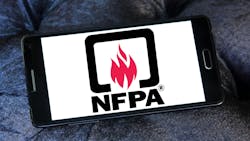Key Highlights
- NFPA 70B covers maintenance requirements for electrical equipment installed per NFPA 70 (NEC), excluding consumer appliances for home use.
- Maintenance professionals should familiarize themselves with NFPA 70B to develop effective maintenance plans and ensure safety compliance.
NFPA 70B is the Standard for Electrical Equipment Maintenance. It applies to the equipment installed per NFPA 70 (the NEC) [NFPA 70B 1.3] and addresses preventive maintenance [1.1]. It does not cover consumer appliances intended primarily for the home [1.3.2].
For the typical maintenance technician, having a copy of this standard isn’t essential. That’s because the typical maintenance technician undergoes training by, uses procedures written by, and performs specific maintenance tasks at intervals decided by, people for whom this standard is written.
For others, having a copy of this standard is essential. Maintenance planners, maintenance managers, maintenance engineers, and CMMS managers need to know this standard. They should know it as thoroughly as a Master Electrician is expected to know the NEC. That is true whether they are in-house maintenance, contract maintenance, or work for specialized firms such as electrical testing firms.
The initial chapters are very short. Then you get to a string of chapters about testing, followed by Chapter 9. This chapter is about maintenance intervals. The main feature of Chapter 9 is Table 9.2.2. This table runs nearly 4 full pages. To use it, you look up the type of asset you are trying to maintain (that’s in the Product column, which is sorted alphabetically). Then you choose the Scope of Work from a list that may vary from only one job (e.g., thermography) to several (e.g., visual inspection, mechanical servicing, electrical testing, etc.). Each of these will have an associated interval. The interval for mechanical servicing of one product may differ from the interval for mechanical servicing for another product.
Chapter 10 pertains to Hazardous Locations. Then starting with Chapter 11, each chapter provides the requirements for a specific type of asset (e.g., power and distribution transformers, busways, lighting, wiring devices, etc.). This series ends with Chapter 36, Stationary Standby Batteries. Chapters 37 and 38 are “reserved” for instrument transformers and control power transformers, respectively.
This is followed by 13 annexes, Annex A through M. These provide detailed information. Three of them (Annex C, D, and E) are devoted to symbols, diagrams, and forms (separately, and in that order). There’s an annex on Reliability Centered Maintenance and another with case histories (it includes black and white photos).
About the Author

Mark Lamendola
Mark is an expert in maintenance management, having racked up an impressive track record during his time working in the field. He also has extensive knowledge of, and practical expertise with, the National Electrical Code (NEC). Through his consulting business, he provides articles and training materials on electrical topics, specializing in making difficult subjects easy to understand and focusing on the practical aspects of electrical work.
Prior to starting his own business, Mark served as the Technical Editor on EC&M for six years, worked three years in nuclear maintenance, six years as a contract project engineer/project manager, three years as a systems engineer, and three years in plant maintenance management.
Mark earned an AAS degree from Rock Valley College, a BSEET from Columbia Pacific University, and an MBA from Lake Erie College. He’s also completed several related certifications over the years and even was formerly licensed as a Master Electrician. He is a Senior Member of the IEEE and past Chairman of the Kansas City Chapters of both the IEEE and the IEEE Computer Society. Mark also served as the program director for, a board member of, and webmaster of, the Midwest Chapter of the 7x24 Exchange. He has also held memberships with the following organizations: NETA, NFPA, International Association of Webmasters, and Institute of Certified Professional Managers.
